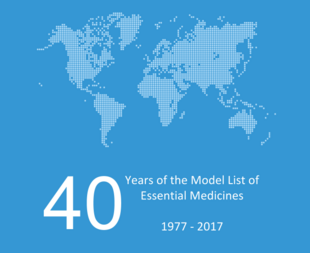
Essential medicines, as defined by the World Health Organization (WHO), are the medicines that "satisfy the priority health care needs of the population".[1] People should ideally have access at all times, in sufficient amounts, and at generally affordable prices.[2]
The WHO has published the list since 1977, updating it every two years, with the current (2021) list for adult patients containing over 400 medicines.[3] Since 2007, a separate list of medicines intended for child has been published.[4]
Both adult and children's lists contain notation indicating if a particular medication is "complementary", thus there are two lists, the "core list" and the "complementary list". The core list presents a list of minimum medicine needs for a basic health care system, listing the most efficacious, safe, and cost-effective medicines for priority conditions. Priority conditions are selected on the basis of current and estimated future public health relevance, and potential for safe and cost-effective treatment. The complementary list presents essential medicines for priority diseases, for which specialized diagnostic or monitoring facilities are needed. In case of doubt medicines may also be listed as complementary on the basis of higher costs or less attractive cost-effectiveness. The list is important as it forms the basis of national drugs policy in more than 155 countries, both in the developed and developing world. Many governments use it to make decisions on health spending. Countries are encouraged to prepare their own lists taking into consideration local priorities. Over 150 countries have published an official essential medicines list.[5]
References edit
- ^ "Essential medicines". World Health Organization (WHO). Archived from the original on October 2, 2008. Retrieved 20 January 2017.
- ^ "The Selection and Use of Essential Medicines (ss 4.2)". Essential Medicines and Health Products Information Portal. WHO Technical Report Series. World Health Organization (WHO). 2003. p. 132. Archived from the original on February 1, 2014.
- ^ "World Health Organization model list of essential medicines: 21st list 2019". World Health Organization. 2019. hdl:10665/325771. Archived from the original on 2020-10-26. Retrieved 2023-07-24.
- ^ "World Health Organization model list of essential medicines for children: 7th list 2019". World Health Organization. 2019. hdl:10665/325772. Archived from the original on 2023-07-09. Retrieved 2023-07-24.
- ^ Seyberth, Hannsjörg W.; Rane, Anders; Schwab, Matthias (2011). Pediatric Clinical Pharmacology. Springer Science & Business Media. p. 358. ISBN 978-3-642-20195-0. Archived from the original on 2023-01-11. Retrieved 2023-07-24.